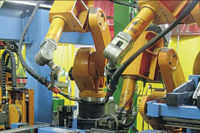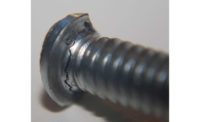ARaymond Automotive has provided custom fasteners, clips, connectors, adhesives and other materials to OEMs and Tier 1 suppliers around the world for nearly 20 years. Its engineers specialize in three processes (fastening, fluid connections and bonding) that are used in all areas of a vehicle.
One such OEM is Renault, which worked closely with ARaymond to ease the assembly of the EOLAB concept car. Unveiled at the Paris Motor Show in September 2014, the Renault EOLAB consumes only 0.004 gallon of fuel and emits 1.2 ounces of CO2 per mile.
Three design factors enable the vehicle to achieve these two benefits, explains Philippe Moutardier, EOLAB fabrication manager at Renault. The first is an aerodynamic design, as great attention was paid to streamlining the vehicle’s body outline, and side flaps were added to further enhance performance. A second factor is ZE Hybrid rechargeable technology, which combines a petrol engine with an electric motor.
Factor three is the car’s light weight. Moutardier says the EOLAB weighs around 880 pounds less than an ordinary B-segment vehicle (3,000 pounds). Design engineers achieved this by using aluminum in several areas of the vehicle, as well as carbon-fiber composites for the floor panels and magnesium for the roof and firewall (bodywork that separates the engine from the driver and passengers).
Joining components to the floor panels presented a major challenge for Renault. Tests showed that standard welding was not possible, and drilling traditional mechanical fasteners into these materials was difficult and could quicken corrosion.
Moutardier then sought the advice of Philippe Michel, global purchasing project manager at Renault and one of the company’s top experts on structural bonding, for an effective alternative to welding and drilling. Michel recommended fasteners be bonded to the panels with TechBond PUR, a heat-activated polyurethane adhesive made by ARaymond.
Designed for both dynamic-stress and permanent-load applications, TechBond PUR comes in dry, bead-shaped pearls and flat tablets. It is suitable for painted metals, glass, plastics, carbon fiber, glass fiber and many other composites.
Fastener bonding is a three-step process that requires a specially designed tool. An assembler loads the fastener into the tool top side down and places the adhesive tablet on top of the fastener bottom. He then positions the loaded tool at a specific attachment point on the bottom of the floor panels, and presses a side button for 5 seconds.
During this time, heat is applied to the fastener, which, in turn, melts the adhesive and secures the fastener. After 50 fasteners are installed, the vehicle subassembly is moved down the assembly line so workers can install exhaust-pipe heat shields, an underbody cable channel, underbody trim, and tubing for pneumatic suspension.
TechBond PUR contains no solvent, produces no waste and leaves no residue on assembly equipment. These benefits are why many automotive manufactures have used it on more than 60 million vehicles over the last 15 years.
ARaymond’s fastener offerings include airbag clips, interior trim fasteners and expansion rivets. The company’s quick connectors offer ease of operation, locking safety and full traceability for fuel lines, and cooling, air conditioning, power steering and brake fluid circuits.








